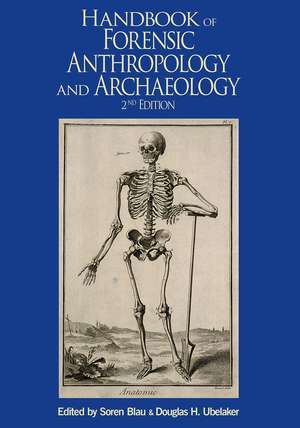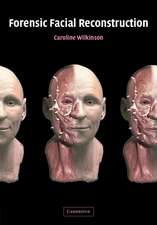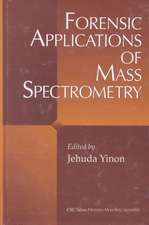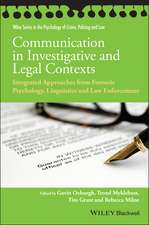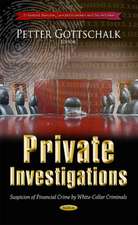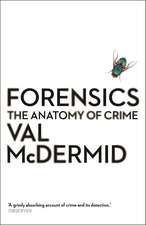Handbook of Forensic Anthropology and Archaeology: WAC Research Handbooks in Archaeology
Editat de Soren Blau, Douglas H. Ubelakeren Limba Engleză Paperback – 27 iul 2016
Preț: 362.74 lei
Preț vechi: 399.09 lei
-9% Nou
Puncte Express: 544
Preț estimativ în valută:
69.42€ • 72.06$ • 57.88£
69.42€ • 72.06$ • 57.88£
Carte tipărită la comandă
Livrare economică 25 martie-08 aprilie
Preluare comenzi: 021 569.72.76
Specificații
ISBN-13: 9781629583853
ISBN-10: 1629583855
Pagini: 738
Ilustrații: photos, charts, tables, notes, references, index
Dimensiuni: 174 x 246 x 46 mm
Greutate: 1.62 kg
Ediția:Revised
Editura: Taylor & Francis
Colecția Routledge
Seria WAC Research Handbooks in Archaeology
Locul publicării:Oxford, United Kingdom
ISBN-10: 1629583855
Pagini: 738
Ilustrații: photos, charts, tables, notes, references, index
Dimensiuni: 174 x 246 x 46 mm
Greutate: 1.62 kg
Ediția:Revised
Editura: Taylor & Francis
Colecția Routledge
Seria WAC Research Handbooks in Archaeology
Locul publicării:Oxford, United Kingdom
Public țintă
PostgraduateCuprins
Chapter 1: Forensic Anthropology and Archaeology: Moving Forward
Soren Blau and Douglas H. Ubelaker
Part I: History of the Disciplines
Chapter 2: Forensic Anthropology and Archaeology in the United Kingdom: Are We Nearly There Yet?
Gaile McKinnon and Karl Harrison
Chapter 3: Forensic Anthropology and Archaeology: Perspectives from Italy
Cristina Cattaneo, Daniele Gibeli, and Dominic Salsarola
Chapter 4: Forensic Anthropology: Perspectives from France
Tania Delabarde and Eric Baccino
Chapter 5: A History of Forensic Anthropology in Spain
José Prieto
Chapter 6: The Application of Forensic Anthropology to the Investigation of Cases of Political Violence: Perspectives from South America
Luis Fondebrider
Chapter 7: The Origin and Development of Forensic Anthropology and Archaeology in Colombia
Angélica Guzmán and César Sanabria Medina
Chapter 8: Historical Development of Forensic Anthropology: Perspectives from the United States
Douglas H. Ubelaker
Chapter 9: Forensic Anthropology: Canadian Content and Contributions
Mark Skinner and Kristina Bowie
Chapter 10: The Development and Current State of Forensic Anthropology: An Australian Perspective
Denise Donlon
Chapter 11: Historical Perspectives of Forensic Anthropology in Indonesia
Etty Indriati
Chapter 12: Forensic Anthropology as Practiced in South Africa
Maryna Steyn, Ericka N. L’Abbé, and Jolandie Myburgh
Part II: Forensic Archaeology
Chapter 13: The Search and Detection of Human Remains
Thomas D. Holland and Samuel V. Connell
Chapter 14: Excavation and Recovery in Forensic Archaeological Investigations
Paul N. Cheetham and Ian Hanson
Part III: Forensic Anthropology
Chapter 15: Differentiating Human from Non-Human Skeletal Remains
Dawn M. Mulhern
Chapter 16: Dating of Anthropological Skeletal Remains of Forensic Interest
Shari Forbes and Kimberley Nugent
Chapter 17: Analysis of Commingled Human Remains
John Byrd and Bradley J. Adams
Chapter 18: The Assessment of Ancestry and the Concept of Race
Norman J. Sauer, Jane C. Wankmiller, and Joseph T. Hefner
Chapter 19: Anthropological Estimation of Sex
Samantha K. Rowbotham
Chapter 20: Skeletal Age Estimation
Tracy L. Rogers
Chapter 21: Histological Age Estimation
Christian M. Crowder, Jarred T. Heinrich, and Victoria M. Dominguez
Chapter 22: Stature Estimation
P. Willey
Chapter 23: Antemortem Trauma
Eugénia Cunha and Joāo Pinheiro
Chapter 24: Perimortem Trauma
Louise Loe
Chapter 25: Forensic Taphonomy
Stephen P. Nawrocki
Chapter 26: Burned Human Remains
Tim Thompson and Priscilla F. Ulguim
Chapter 27: Craniofacial Identification: Techniques of Facial Approximation and Craniofacial Superimposition
Carl N. Stephan and Peter Claes
Chapter 28: Biomolecular Applications
Lori Baker
Chapter 29: Forensic Odontology
John Gerald Clement
Part IV: The Crime and Disaster Scene: Case Studies in Forensic Archaeology and Anthropology
Chapter 30: Investigative and Legal Aspects of a U.S. Federal Death Penalty Case
Dawnie Wolfe Steadman, William Basler, Michael J. Hochrein, Dennis F. Klein, and Julia C. Goodin
Chapter 31: Domestic Homicide Investigations in the United Kingdom
John Hunter
Chapter 32: Forensic Anthropology in Disaster Response
Paul S. Sledzik and Amy Z. Mundorff
Chapter 33: Medico-legal Investigation of Atrocities Committed during the Solomon Islands “Ethnic Tensions”
Melanie Archer and Malcolm J. Dodd
Chapter 34: Disaster Anthropology: The 2004 Asian Tsunami
Sue Black
Chapter 35: The Role of the Anthropologist in Disaster Victim Identification: Case studies from the 2002 and 2004 terrorist attacks in Bali, Indonesia
Alanah M. Buck and Christopher A. Briggs
Chapter 36: Dealing with Human Remains from Recent Conflict: Mass Grave Excavations and Human Identification in a Sensitive Political Context
Marija Djurić
Chapter 37: Forensic Investigations in Guatemala: The Continuing Search for Truth, Justice, and the Missing Two Decades after the Peace Accords
Caroline Barker, Ambika Flavel, and Claudia Rivera Fernández
Chapter 38: Continuing Challenges for Forensic Archaeology and Anthropology in Iraq
Derek Congram, Jon Sterenberg, and Oran Finnegan
Chapter 39: Fromelles: Forensic Archaeology and Anthropology in Identification
Margaret Cox, Louise Loe, and Peter Jones
Part V: The Professional Forensic Archaeologist and the Forensic Anthropologist
Chapter 40: More Than Just Bare Bones: Ethical Considerations for Forensic Anthropologists
Soren Blau
Chapter 41: How to Do Forensic Anthropology under the Auspices of the United Nations and Other Large Organizations
Richard Wright and Ian Hanson
Chapter 42: Contribution of Quantitative Methods in Forensic Anthropology: A New Era
Ann H. Ross and Erin H. Kimmerle
Chapter 43: The Expert Witness and the Court of Law
Maciej Henneberg
Chapter 44: Legal Aspects of Identification
David Ranson
Chapter 45: The International Commission on Missing Persons (ICMP) and the Application of Forensic Archaeology and Anthropology to Identifying the Missing
Ian Hanson, Matthew Holliday, Kevin Sullivan, Kathryne Bomberger, and Thomas J. Parsons
Chapter 46: Conclusion: International Perspectives on Issues in Forensic Anthropology
Soren Blau and Douglas H. Ubelaker
Soren Blau and Douglas H. Ubelaker
Part I: History of the Disciplines
Chapter 2: Forensic Anthropology and Archaeology in the United Kingdom: Are We Nearly There Yet?
Gaile McKinnon and Karl Harrison
Chapter 3: Forensic Anthropology and Archaeology: Perspectives from Italy
Cristina Cattaneo, Daniele Gibeli, and Dominic Salsarola
Chapter 4: Forensic Anthropology: Perspectives from France
Tania Delabarde and Eric Baccino
Chapter 5: A History of Forensic Anthropology in Spain
José Prieto
Chapter 6: The Application of Forensic Anthropology to the Investigation of Cases of Political Violence: Perspectives from South America
Luis Fondebrider
Chapter 7: The Origin and Development of Forensic Anthropology and Archaeology in Colombia
Angélica Guzmán and César Sanabria Medina
Chapter 8: Historical Development of Forensic Anthropology: Perspectives from the United States
Douglas H. Ubelaker
Chapter 9: Forensic Anthropology: Canadian Content and Contributions
Mark Skinner and Kristina Bowie
Chapter 10: The Development and Current State of Forensic Anthropology: An Australian Perspective
Denise Donlon
Chapter 11: Historical Perspectives of Forensic Anthropology in Indonesia
Etty Indriati
Chapter 12: Forensic Anthropology as Practiced in South Africa
Maryna Steyn, Ericka N. L’Abbé, and Jolandie Myburgh
Part II: Forensic Archaeology
Chapter 13: The Search and Detection of Human Remains
Thomas D. Holland and Samuel V. Connell
Chapter 14: Excavation and Recovery in Forensic Archaeological Investigations
Paul N. Cheetham and Ian Hanson
Part III: Forensic Anthropology
Chapter 15: Differentiating Human from Non-Human Skeletal Remains
Dawn M. Mulhern
Chapter 16: Dating of Anthropological Skeletal Remains of Forensic Interest
Shari Forbes and Kimberley Nugent
Chapter 17: Analysis of Commingled Human Remains
John Byrd and Bradley J. Adams
Chapter 18: The Assessment of Ancestry and the Concept of Race
Norman J. Sauer, Jane C. Wankmiller, and Joseph T. Hefner
Chapter 19: Anthropological Estimation of Sex
Samantha K. Rowbotham
Chapter 20: Skeletal Age Estimation
Tracy L. Rogers
Chapter 21: Histological Age Estimation
Christian M. Crowder, Jarred T. Heinrich, and Victoria M. Dominguez
Chapter 22: Stature Estimation
P. Willey
Chapter 23: Antemortem Trauma
Eugénia Cunha and Joāo Pinheiro
Chapter 24: Perimortem Trauma
Louise Loe
Chapter 25: Forensic Taphonomy
Stephen P. Nawrocki
Chapter 26: Burned Human Remains
Tim Thompson and Priscilla F. Ulguim
Chapter 27: Craniofacial Identification: Techniques of Facial Approximation and Craniofacial Superimposition
Carl N. Stephan and Peter Claes
Chapter 28: Biomolecular Applications
Lori Baker
Chapter 29: Forensic Odontology
John Gerald Clement
Part IV: The Crime and Disaster Scene: Case Studies in Forensic Archaeology and Anthropology
Chapter 30: Investigative and Legal Aspects of a U.S. Federal Death Penalty Case
Dawnie Wolfe Steadman, William Basler, Michael J. Hochrein, Dennis F. Klein, and Julia C. Goodin
Chapter 31: Domestic Homicide Investigations in the United Kingdom
John Hunter
Chapter 32: Forensic Anthropology in Disaster Response
Paul S. Sledzik and Amy Z. Mundorff
Chapter 33: Medico-legal Investigation of Atrocities Committed during the Solomon Islands “Ethnic Tensions”
Melanie Archer and Malcolm J. Dodd
Chapter 34: Disaster Anthropology: The 2004 Asian Tsunami
Sue Black
Chapter 35: The Role of the Anthropologist in Disaster Victim Identification: Case studies from the 2002 and 2004 terrorist attacks in Bali, Indonesia
Alanah M. Buck and Christopher A. Briggs
Chapter 36: Dealing with Human Remains from Recent Conflict: Mass Grave Excavations and Human Identification in a Sensitive Political Context
Marija Djurić
Chapter 37: Forensic Investigations in Guatemala: The Continuing Search for Truth, Justice, and the Missing Two Decades after the Peace Accords
Caroline Barker, Ambika Flavel, and Claudia Rivera Fernández
Chapter 38: Continuing Challenges for Forensic Archaeology and Anthropology in Iraq
Derek Congram, Jon Sterenberg, and Oran Finnegan
Chapter 39: Fromelles: Forensic Archaeology and Anthropology in Identification
Margaret Cox, Louise Loe, and Peter Jones
Part V: The Professional Forensic Archaeologist and the Forensic Anthropologist
Chapter 40: More Than Just Bare Bones: Ethical Considerations for Forensic Anthropologists
Soren Blau
Chapter 41: How to Do Forensic Anthropology under the Auspices of the United Nations and Other Large Organizations
Richard Wright and Ian Hanson
Chapter 42: Contribution of Quantitative Methods in Forensic Anthropology: A New Era
Ann H. Ross and Erin H. Kimmerle
Chapter 43: The Expert Witness and the Court of Law
Maciej Henneberg
Chapter 44: Legal Aspects of Identification
David Ranson
Chapter 45: The International Commission on Missing Persons (ICMP) and the Application of Forensic Archaeology and Anthropology to Identifying the Missing
Ian Hanson, Matthew Holliday, Kevin Sullivan, Kathryne Bomberger, and Thomas J. Parsons
Chapter 46: Conclusion: International Perspectives on Issues in Forensic Anthropology
Soren Blau and Douglas H. Ubelaker
Recenzii
"… [T]his volume is indeed comprehensive. The Editors should be congratulated on an excellent book, which should be on the bookshelf of any serious practitioner and library. The Editors state that the ‘methodologies summarized in this volume are state of the art but hardly the last word.’ However, this book should remain highly relevant for many years to come. Highly recommended!""
- James Robertson, Australian Journal of Forensic Sciences, review of the first edition
"This superb volume brings together contributions from practicing professionals in Australia, Canada, France, Great Britain, Guatemala, Indonesia, Italy, Spain, and the United States. … For those individuals considering specializing in forensic anthropology, or applying their archaeological skills in the search, documentation, and recovery of human remains and evidence derived from non-archaeological contexts, this book inserts a large dose of reality into what it means to be an anthropologist first and a forensic anthropologist second."
- Leslie E. Eisenberg, Journal of Forensic Sciences, review of the first edition
- James Robertson, Australian Journal of Forensic Sciences, review of the first edition
"This superb volume brings together contributions from practicing professionals in Australia, Canada, France, Great Britain, Guatemala, Indonesia, Italy, Spain, and the United States. … For those individuals considering specializing in forensic anthropology, or applying their archaeological skills in the search, documentation, and recovery of human remains and evidence derived from non-archaeological contexts, this book inserts a large dose of reality into what it means to be an anthropologist first and a forensic anthropologist second."
- Leslie E. Eisenberg, Journal of Forensic Sciences, review of the first edition
Descriere
With contributions from 70 experienced practitioners from around the world, this second edition of the authoritative Handbook of Forensic Archaeology and Anthropology provides a solid foundation in both the practical and ethical components of forensic work. The book weaves together the discipline’s historical development; current field methods for analyzing crime, natural disasters, and human atrocities; an array of laboratory techniques; key case studies involving legal, professional, and ethical issues; and ideas about the future of forensic work--all from a global perspective. This fully revised second edition expands the geographic representation of the first edition by including chapters from practitioners in South Africa and Colombia, and adds exciting new chapters on the International Commission on Missing Persons and on forensic work being done to identify victims of the Battle of Fromelles during World War I.
